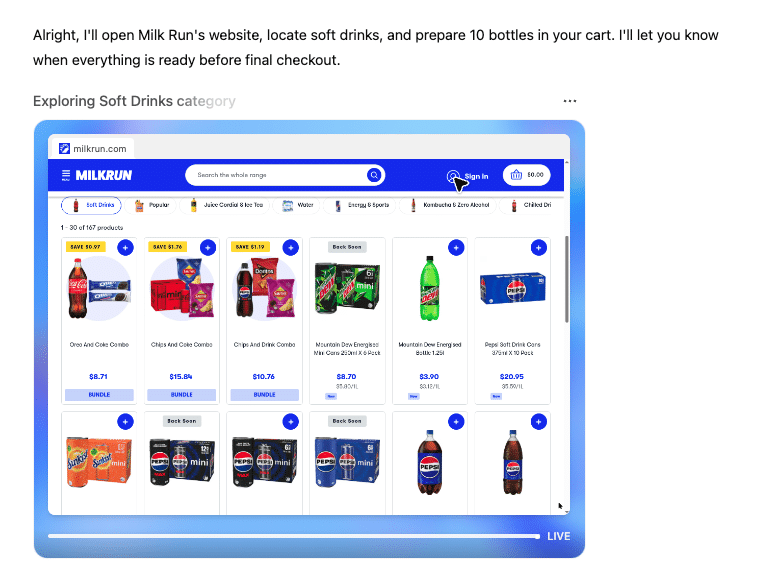In the early 2010s, we all started writing web content for Google. Not just for humans. Suddenly, structure, clarity and keyword use weren’t just nice to have—they were critical. SEO shifted how we wrote, laid out pages and thought about content. Design had to consider machines too.
We’re at that moment again—but this time, it’s not just Google crawling your site. It’s OpenAI’s new agents acting like actual users.
These agents aren’t just scraping data. They browse, click, fill out forms, pay for things and complete tasks—autonomously. And they’re doing it live on your website. Think of them as digital assistants you can brief with a single sentence, and they’ll handle the rest (no Slack messages or coffee required).

We tested that theory the way any curious creative studio would: we asked one to sort out morning tea.
The morning tea prompt that broke the internet (almost)
Here’s the prompt we gave OpenAI’s new agent feature:
“Organise morning tea for 5 people, don’t spend more than $30 and use Milkrun. Ensure it’s delivered to 121 Doveton Street North, Ballarat VIC 3350 as soon as possible.”
That’s it. No special formatting. Just what you’d say to a team member on a regular workday.
To its credit, the agent launched Milkrun in-browser, found food and drink options, changed our delivery address, selected items, showed us the cart, confirmed the order with us, and—after approval—paid and checked out. Job done.
But watching the process in action was like watching someone attempt to cook a three-course meal using only instructions from IKEA. Technically possible. Emotionally painful.
The cracks in modern UX started showing immediately.
What made it struggle—and why that matters
The agent wasn’t dumb. It didn’t fail because it lacked capability. It struggled because most websites are designed with only humans in mind. We rely on visual cues, intuition, and timing. AI agents? Not so much.
Here’s where things went sideways:
-
Popup hell: Cookie banners, newsletter modals and discount popups derailed the agent. It didn’t always recognise how to dismiss them.
-
Hover-only states: Menus and buttons that reveal more on hover were missed entirely. The agent can’t hover. It can only click.
-
Slow rendering: Delayed JavaScript content made it think the page was ready before it was. It clicked too early—or skipped key content.
-
Ambiguous buttons: Unlabelled or context-dependent buttons like “Continue” made it second-guess what action to take next.
-
Nested dropdowns: Deep, dynamic dropdown menus confused its decision-making, especially if they weren’t properly structured in the DOM.
Now imagine this happening not just for morning tea, but for any digital task—from making a dentist appointment to renewing your license.
If a digital assistant can’t complete a task because the “close” button on your popup isn’t labelled, that’s not a tech problem. That’s a design problem.

UX is no longer just for humans
The morning tea test made something clear: we’re no longer just designing interfaces for people. We’re designing for the people who delegate to machines.
It’s a fundamental shift. Just like SEO made us write for crawlers as well as readers, AI agents now require us to design for software as well as sight.
And just like bad SEO structure makes content invisible to Google, bad UX can make a website unusable for an AI agent.
What designing for AI agents actually looks like
So what changes?
Do we throw out everything we know about UI and UX? No. In fact, designing for AI agents is often just designing better for humans, too.
Here’s what we need to prioritise:
1. Semantic structure
Use proper HTML markup. Headings should be headings. Buttons should be buttons (not divs styled to look clickable). Inputs should be clearly labelled.
2. Accessible interactions
Avoid hover-only or animation-dependent actions. Ensure buttons and controls are visible and actionable without requiring motion or timing.
3. Clear labels and predictable flows
“Submit” is vague. “Place Order” is clear. Use labels that tell the agent exactly what’s happening next.
4. No disruptive modals mid-flow
Popups that interrupt critical steps confuse both humans and machines. Let people (and agents) complete their task before offering them a newsletter or discount code.
5. Test like a robot
Use headless browsers or tools like Puppeteer to mimic what an AI agent might see. If your flow breaks, fix it—not just for bots, but for accessibility and consistency too.
Why this isn’t a niche issue—it’s the next standard
Some might argue that designing for AI agents is premature. “Real people” are still clicking, right?
Sure. But look back at SEO. In the beginning, only a few people optimised their sites. Then suddenly, if you weren’t optimising, you weren’t being found.
The same pattern’s emerging here.
-
Assistants like ChatGPT, Siri, and Google Assistant are evolving.
-
Businesses are building AI-powered services on top of existing websites.
-
Automations are becoming standard in workplace tools.
In short: these agents will be a big part of how people interact with digital experiences, whether directly or indirectly.
And when those experiences fail—because your “Add to Cart” button only appears on mouseover—it reflects badly on you, not the agent.
The quiet revolution: design that scales past the screen
What makes this shift different is how quietly it’s happening.
There’s no big platform announcement. No iOS release changing the rules overnight. Just more and more tasks being handed over to agents—automated checkouts, AI-based booking flows, integrations with task runners like Zapier or Notion.
As designers, we love to talk about empathy. But we often design with one kind of user in mind. The AI agent isn’t replacing the human—it’s acting on their behalf. If we’re truly designing for people, we have to make sure their digital assistants don’t hit dead ends.
Morning tea was just the beginning. And while the delivery showed up, the process revealed how fragile our “intuitive” interfaces really are.
Final thought: humans still matter—but now so do their robots
This isn’t a future problem. It’s a right-now problem. AI agents are clicking through websites, placing orders, and filling out forms today. If they can’t do it easily, your customers can’t either—not through them, at least.
We’ve adapted our content for search engines. We’ve designed for accessibility. Now we design for AI agents—not because they’re replacing people, but because people are increasingly leaning on them.
The next time you ship a product or redesign a flow, ask yourself:
Would a robot know what to do here?
Because if not, your user’s assistant just failed—and so did the experience.
